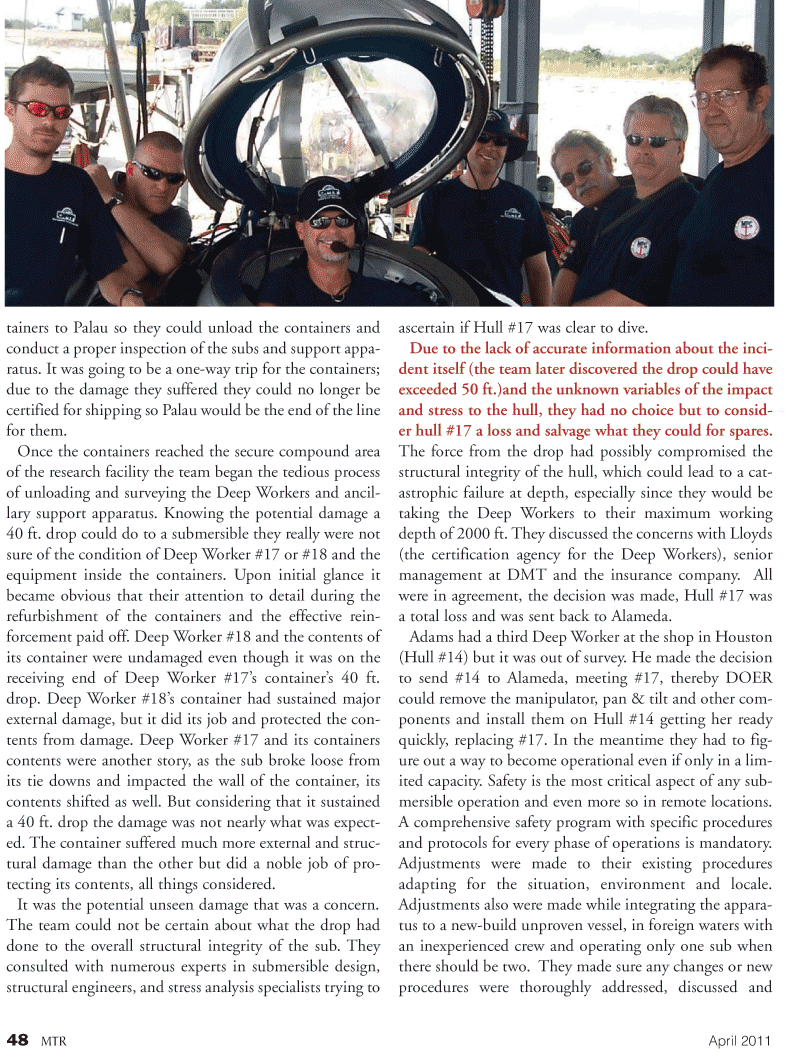
Page 48: of Marine Technology Magazine (April 2011)
Oil & Gas SubSea Monitoring
Read this page in Pdf, Flash or Html5 edition of April 2011 Marine Technology Magazine
48 MTR April 2011 tainers to Palau so they could unload the containers and conduct a proper inspection of the subs and support appa- ratus. It was going to be a one-way trip for the containers; due to the damage they suffered they could no longer be certified for shipping so Palau would be the end of the line for them.
Once the containers reached the secure compound area of the research facility the team began the tedious process of unloading and surveying the Deep Workers and ancil- lary support apparatus. Knowing the potential damage a 40 ft. drop could do to a submersible they really were not sure of the condition of Deep Worker #17 or #18 and the equipment inside the containers. Upon initial glance it became obvious that their attention to detail during the refurbishment of the containers and the effective rein- forcement paid off. Deep Worker #18 and the contents of its container were undamaged even though it was on the receiving end of Deep Worker #17’s container’s 40 ft. drop. Deep Worker #18’s container had sustained major external damage, but it did its job and protected the con- tents from damage. Deep Worker #17 and its containers contents were another story, as the sub broke loose from its tie downs and impacted the wall of the container, its contents shifted as well. But considering that it sustained a 40 ft. drop the damage was not nearly what was expect- ed. The container suffered much more external and struc- tural damage than the other but did a noble job of pro- tecting its contents, all things considered.
It was the potential unseen damage that was a concern.
The team could not be certain about what the drop had done to the overall structural integrity of the sub. They consulted with numerous experts in submersible design, structural engineers, and stress analysis specialists trying to ascertain if Hull #17 was clear to dive.
Due to the lack of accurate information about the inci- dent itself (the team later discovered the drop could have exceeded 50 ft.)and the unknown variables of the impact and stress to the hull, they had no choice but to consid- er hull #17 a loss and salvage what they could for spares.
The force from the drop had possibly compromised the structural integrity of the hull, which could lead to a cat- astrophic failure at depth, especially since they would be taking the Deep Workers to their maximum working depth of 2000 ft. They discussed the concerns with Lloyds (the certification agency for the Deep Workers), senior management at DMT and the insurance company. All were in agreement, the decision was made, Hull #17 was a total loss and was sent back to Alameda.
Adams had a third Deep Worker at the shop in Houston (Hull #14) but it was out of survey. He made the decision to send #14 to Alameda, meeting #17, thereby DOER could remove the manipulator, pan & tilt and other com- ponents and install them on Hull #14 getting her ready quickly, replacing #17. In the meantime they had to fig- ure out a way to become operational even if only in a lim- ited capacity. Safety is the most critical aspect of any sub- mersible operation and even more so in remote locations.
A comprehensive safety program with specific procedures and protocols for every phase of operations is mandatory.
Adjustments were made to their existing procedures adapting for the situation, environment and locale.
Adjustments also were made while integrating the appara- tus to a new-build unproven vessel, in foreign waters with an inexperienced crew and operating only one sub when there should be two. They made sure any changes or new procedures were thoroughly addressed, discussed and

 47
47

 49
49
